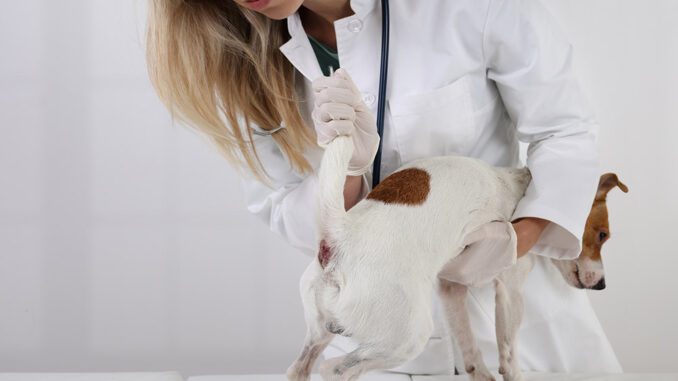
This article was updated on August 26th, 2023
As a veterinarian, anal gland expression forms part of our daily routine. This smelly job is essential to keep many dogs comfortable. In this article, we’ll delve into the world of anal glands in dogs, how to identify when and how often they need expressing, and strategies to prevent and manage potential issues.
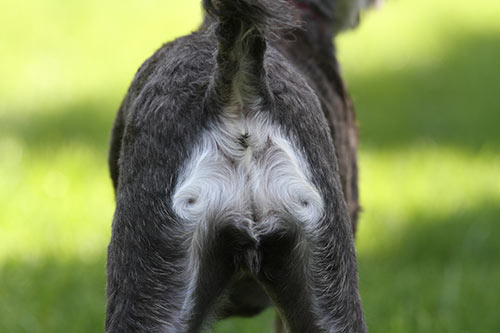
Overview of anal glands in dogs
Anal glands, also known as anal sacs, are small structures located on either side of the anus towards the bottom of the anus. If you imagine the anus to be a clock-face, the anal glands are positioned at the 4 and 8 o’clock position. The are just under the skin and empty into the last portion of the rectum.
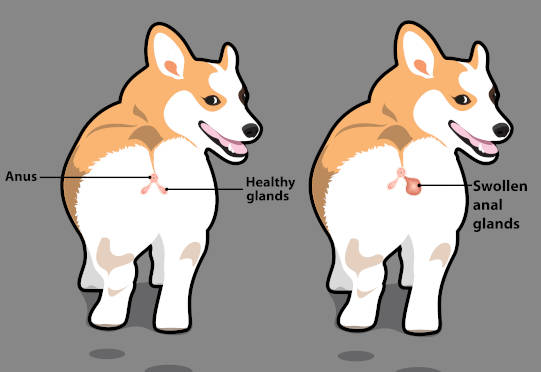
The function of these glands is to produce a liquid that gives information about that dog, e.g. gender, age, and sexual status, in the form of scents and pheromones. Dogs then use these glands to mark their territories and to aid in communication with one another.
Usually, the anal glands are emptied when the dog has a normal bowel movement. The pressure of the stool moving past the glands expresses the contents onto the stool. Normally the fluid is liquid, brown and has a distinct fishy color. If it is thick, green, black, reddish or has a granular consistency then it is abnormal.
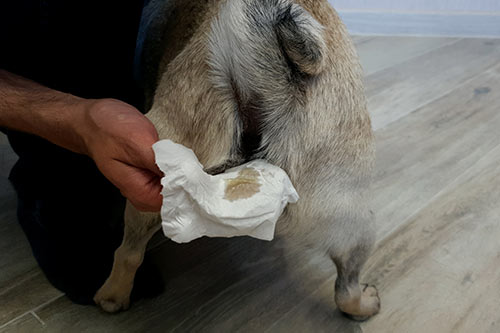
Some dogs may struggle to empty their anal glands naturally. This may occur due to infection in the glands, constipation, diarrhea, abnormal anatomy of the anal glands or even arthritis of the hips or lumbar spine.
How often should I express my dog’s anal glands?
Most dogs will NOT require anal gland expression. Only a small proportion of the dog population struggle to express their anal glands on their own. If they do struggle, it is important to get a vet assessment to rule out anal gland infections and any other underlying conditions.
Once the underlying conditions have been cleared up, your vet will advise you on how frequently the anal glands should be expressed. Generally every 1-3 months will be adequate, but this varies from dog to dog.
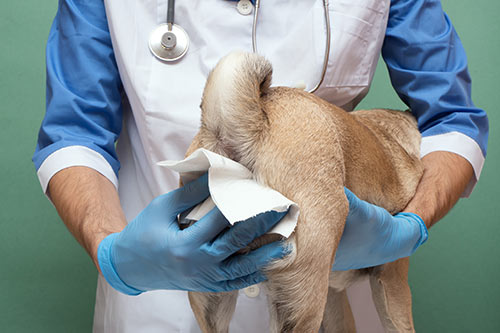
It’s important to look out for signs and symptoms that your dog is struggling and to act immediately to prevent infections and other complications.
Signs that your dog’s anal glands need expression
Watch out for signs like excessive licking of the anal area, scooting their rear end on the ground, discomfort while defecating, or a strong, foul odor around their hindquarters. Some dog’s will also have a swollen, red anus or you may notice that they are struggling to pass stool. If you notice any of these behaviors, it’s time to consider expressing the anal glands.
Preventing anal gland issues with home remedies and lifestyle changes
1. Maintain a healthy weight
Obesity and inactivity can contribute to anal gland problems. It’s essential to maintain a healthy weight. Ensure your dog gets regular exercise and monitor their calorie intake, including treats. Taking your dog for regular walks also encourages regular bowel movements and can help prevent build-up of the anal gland secretions.
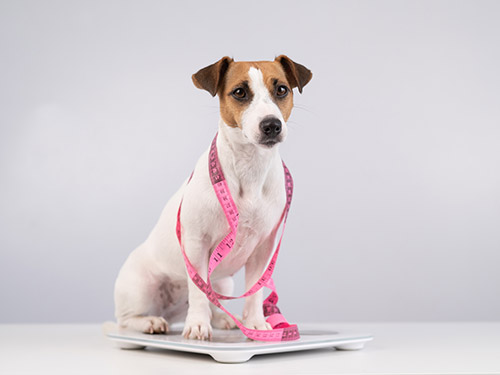
2. Feed a high fiber diet
Switching to a high-fiber diet can promote regular bowel movements and potentially help prevent gland blockages. Your vet may recommend a prescription diet for your dog. Alternatively, increasing the fibre using digestive bran can be helpful. Pumpkin can be a great source of fibre and can help with natural anal gland expression.
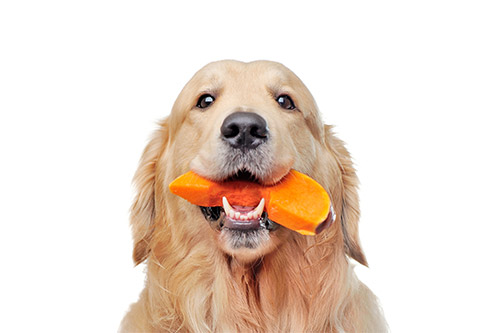
3. Use warm compresses
If you observe any signs of irritation, applying a warm compress to the area under your dog’s tail can help soften the secretions, making it easier for your dog to express them naturally. Be sure to wrap the compress in a towel to prevent burns to the area.
Apply the warm compress to the area under his tail for 5-10 minutes two to three times a day. This will help to soften and liquefy the secretions to help your dog express the anal glands more easily. Make sure the warm compress is not too hot. Have somebody help keep your dog calm and feed them treats while doing this to encourage them to accept the warm compress. If the area is particularly painful then they may get snappy.
How to express your dog’s anal glands
At Home
While expressing anal glands at home is possible, it’s recommended to consult your veterinarian or vet technician for proper guidance. Be sure to have someone assist you and control your dog’s head. Even the sweetest dog may not take kindly to the procedure, and they may bite.
The external method:
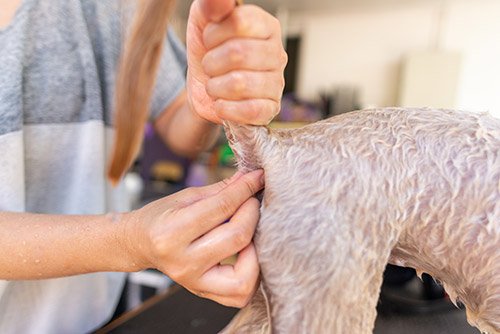
Put some gloves on your hands and prepare lubricant. Liquid soap or petroleum jelly can work well. Lubricate your thumb and index finger. Hold some cotton wool in your hand and gently feel on other side of the rectum to find the anal glands.
Once you have located them put gentle pressure on them using your forefinger and thumb. Milk the contents out towards the anus. Catch any liquid that comes out on the cotton wool and then clean the area well with dog safe shampoo. You may not completely empty the anal glands using this method, but it is fairly easy and well tolerated by the dog.
The internal method:
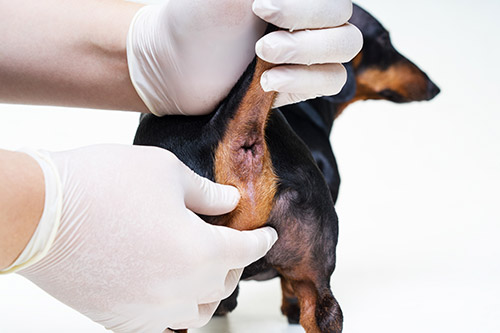
This method empties the glands more completely but can be very uncomfortable for the dog. If your nails are sharp, you may also damage the rectum. Only use this method if you have been trained by a veterinarian or veterinary technician. Make sure your dog is very well restrained.
Put on a pair of latex or similar gloves and prepare some cotton wool or paper towel. Put some lubricant on glove on your index finger. Liquid soap or petroleum jelly work well. Insert your finger into the anus gently. Using your index finger and thumb feel along the sides of the anus towards the bottom of the anus. You will feel two fluid filled sacs (ranging in size from pea size to grape size).
Hold the anal gland between your index finger and thumb and push gently from the outside towards the inside of the anus. The liquid should come out easily. If it does not or if your dog is distressed, then it is best to get a vet to investigate. Be sure to clean the area outside the anus with a dog safe shampoo to prevent the smell from lingering. .
At the vet or groomer
Both vet techs and groomers can perform routine anal gland expression. However, in complex cases or if the issue persists, a veterinarian’s expertise might be necessary.
When to seek veterinary assistance
A wait-and-see approach might be suitable for minor issues. If discomfort persists beyond 48 hours, consult your veterinarian. Seek immediate assistance if you notice signs of infection, intense pain, swelling, or abscess formation. If the problem is recurrent or causes your dog significant pain, discuss long term management options with your vet. In some cases, removing the anal glands completely is the best course of action.
Frequently Asked Questions
What are the risks associated with expressing anal glands?
While the process itself is generally safe, there’s a small risk of injury or infection if not done correctly. If your dog is very painful or is a sensitive dog, be very careful to avoid injury to yourself.
What should I do if the glands look infected?
If the anal glands are difficult to express or if the fluid is thick, pungent, yellow, white, green of blood-tinged, then your dog may have an anal gland infection. Prompt treatment by a vet is essential to prevent abscesses and other complications.
Can diet affect the frequency of anal gland expression?
Yes, absolutely. A high fibre diet can help reduce the need for anal gland expression. In some cases, dogs with food allergies may also develop anal gland issues and switching over to a hypoallergenic diet may be helpful.
What should I do if my dog has persistent anal gland issues?
If problems continue, consult your veterinarian for a comprehensive evaluation. The vet needs to look out for any underlying conditions or complicating factors to help resolve the anal gland problem.
Conclusion
Understanding your dog’s anal gland health is a crucial part of responsible pet ownership. By recognizing the signs of discomfort and taking preventive measures, you can help keep your furry companion happy and healthy. Remember, if in doubt, always consult your veterinarian for the best guidance tailored to your dog’s individual needs.
Related posts:
Disclaimer: This website's content is not a substitute for veterinary care. Always consult with your veterinarian for healthcare decisions. Read More.

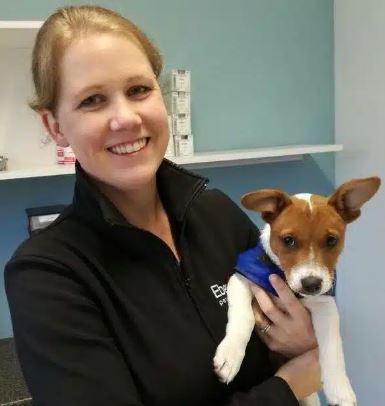








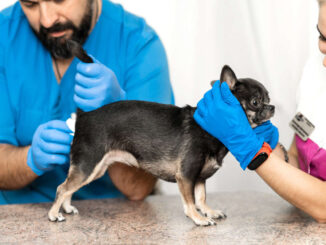

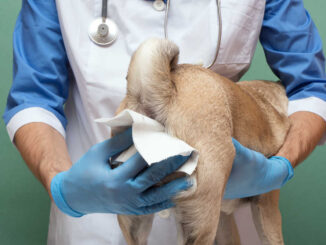
Be the first to comment